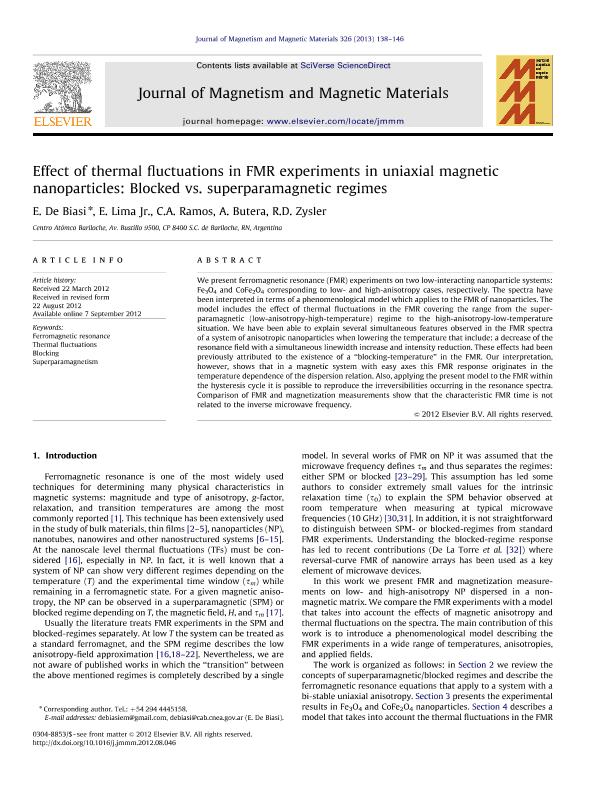Artículo
Effect of Thermal Fluctuations in FMR Experiments in Uniaxial Magnetic Nanoparticles: Blocked vs. Superparamagnetic Regimes
de Biasi, Emilio ; Lima Jr., Enio; Ramos, Carlos A.; Butera, Alejandro Ricardo
; Lima Jr., Enio; Ramos, Carlos A.; Butera, Alejandro Ricardo ; Zysler, Roberto Daniel
; Zysler, Roberto Daniel
 ; Lima Jr., Enio; Ramos, Carlos A.; Butera, Alejandro Ricardo
; Lima Jr., Enio; Ramos, Carlos A.; Butera, Alejandro Ricardo ; Zysler, Roberto Daniel
; Zysler, Roberto Daniel
Fecha de publicación:
01/2013
Editorial:
Elsevier Science
Revista:
Journal Of Magnetism And Magnetic Materials
ISSN:
0304-8853
Idioma:
Inglés
Tipo de recurso:
Artículo publicado
Clasificación temática:
Resumen
We present ferromagnetic resonance (FMR) experiments on two low-interacting nanoparticle systems: Fe3O4 and CoFe2O4 corresponding to low- and high-anisotropy cases, respectively. The spectra have been interpreted in terms of a phenomenological model which applies to the FMR of nanoparticles. The model includes the effect of thermal fluctuations in the FMR covering the range from the superparamagnetic (low-anisotropy-high-temperature) regime to the high-anisotropy-low-temperature situation. We have been able to explain several simultaneous features observed in the FMR spectra of a system of anisotropic nanoparticles when lowering the temperature that include: a decrease of the resonance field with a simultaneous linewidth increase and intensity reduction. These effects had been previously attributed to the existence of a ‘‘blocking-temperature’’ in the FMR. Our interpretation, however, shows that in a magnetic system with easy axes this FMR response originates in the temperature dependence of the dispersion relation. Also, applying the present model to the FMR within the hysteresis cycle it is possible to reproduce the irreversibilities occurring in the resonance spectra. Comparison of FMR and magnetization measurements show that the characteristic FMR time is not related to the inverse microwave frequency.
Palabras clave:
Ferromagnetic Resonance
,
Thermal Fluctuations
,
Bloking
,
Superparamagnetism
Archivos asociados
Licencia
Identificadores
Colecciones
Articulos(CCT - PATAGONIA NORTE)
Articulos de CTRO.CIENTIFICO TECNOL.CONICET - PATAGONIA NORTE
Articulos de CTRO.CIENTIFICO TECNOL.CONICET - PATAGONIA NORTE
Citación
de Biasi, Emilio; Lima Jr., Enio; Ramos, Carlos A.; Butera, Alejandro Ricardo; Zysler, Roberto Daniel; Effect of Thermal Fluctuations in FMR Experiments in Uniaxial Magnetic Nanoparticles: Blocked vs. Superparamagnetic Regimes; Elsevier Science; Journal Of Magnetism And Magnetic Materials; 326; 1-2013; 138-146
Compartir
Altmétricas



